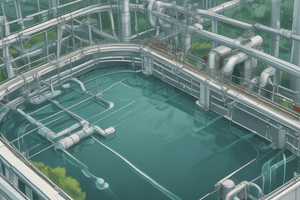Podcast
Questions and Answers
What is a disadvantage of forced aeration in fixed bed bioreactors?
What is a disadvantage of forced aeration in fixed bed bioreactors?
- Water evaporation and substrate drying (correct)
- Enhanced microbial activity
- Efficient heat removal
- High water activity (aw) and humidity
Why are column reactors considered the most studied in the laboratory scale?
Why are column reactors considered the most studied in the laboratory scale?
- Increased heat removal efficiency
- Minimization of temperature gradients (correct)
- Enhanced bacterial contamination
- Improved water activity (aw)
How is temperature control achieved in column reactors?
How is temperature control achieved in column reactors?
- By increasing water evaporation
- By reducing porosity of the bed
- By placing the reactor in a bath or using tactical terms columns jacketed with circulating coolant (correct)
- By implementing processes on solid medium
What advantage do column reactors have over tray reactors in terms of bacterial contamination?
What advantage do column reactors have over tray reactors in terms of bacterial contamination?
What is a challenge associated with the progress of fermentation in column reactors?
What is a challenge associated with the progress of fermentation in column reactors?
Which type of bioreactor is primarily used for the production of biomass such as cells, shoots, or roots?
Which type of bioreactor is primarily used for the production of biomass such as cells, shoots, or roots?
What type of bioreactor has been modified with a variety of impeller designs distinct from blade turbines for agitation?
What type of bioreactor has been modified with a variety of impeller designs distinct from blade turbines for agitation?
Which type of bioreactor is used for the biotransformation of exogenously added metabolites?
Which type of bioreactor is used for the biotransformation of exogenously added metabolites?
What type of bioreactor is fundamentally classified by agitation methods and vessel construction into mechanically agitated, rotating drum, and spin filter bioreactors?
What type of bioreactor is fundamentally classified by agitation methods and vessel construction into mechanically agitated, rotating drum, and spin filter bioreactors?
Which type of bioreactor is specifically designed to allow better conditions for plant cell cultures, including a variety of impeller designs distinct from blade turbines for agitation?
Which type of bioreactor is specifically designed to allow better conditions for plant cell cultures, including a variety of impeller designs distinct from blade turbines for agitation?
What is the main focus of the study carried out by Prakash and Srivastava in the stirred tank bioreactor?
What is the main focus of the study carried out by Prakash and Srivastava in the stirred tank bioreactor?
What is the significant advantage of bubble columns for plant cell cultures, as mentioned in the text?
What is the significant advantage of bubble columns for plant cell cultures, as mentioned in the text?
In which type of bioreactor was the effect of elicitation with fatty acids investigated by Wu et al (2009)?
In which type of bioreactor was the effect of elicitation with fatty acids investigated by Wu et al (2009)?
What material is used to make the Bioreactor of Immersion by Bubbles developed by Soccol et al (2008)?
What material is used to make the Bioreactor of Immersion by Bubbles developed by Soccol et al (2008)?
What kind of impeller was used in the stirred tank bioreactor compared with the centrifugal impeller bioreactor in the study by Prakash and Srivastava?
What kind of impeller was used in the stirred tank bioreactor compared with the centrifugal impeller bioreactor in the study by Prakash and Srivastava?
Flashcards are hidden until you start studying
Study Notes
Interest in Plant Cell Cultures
- Growing utilization of plant cell cultures for pharmaceuticals, flavors, fragrances, and fine chemicals.
- Potential for natural product production significant due to sustainability and diversity of plant sources.
Challenges in Commercial Exploitation
- Low and unstable cell productivity hampers consistent output.
- Slow growth rates limit scalability for commercial applications.
- Genetic instability poses challenges for predictable product quality.
- Difficulty in maintaining photoautotrophic growth restricts cultivation efficiency.
Bioreactor Design Considerations
- Unique characteristics of plant cell cultures must be accounted for in bioreactor design:
- Larger cell sizes and complex morphologies present engineering challenges.
- Aggregation tendency affects uniformity and performance in cultures.
- Time-dependent rheological behavior complicates fluid dynamics in bioreactors.
- Foaming issues can lead to contamination and reduced efficiency.
- Wall growth may impede optimal nutrient and gas transfer.
- Shear sensitivity requires careful control of mixing and aeration.
- Relatively low growth and oxygen uptake rates necessitate specific nutrient management.
Importance of Bioreactor Operation
- Design and operation of bioreactors critical for successful large-scale plant cell culture production.
- Culturing practices for plant cells share similarities with mammalian cell growth but necessitate distinct nutritional and control adjustments.
- Comprehensive reviews on implications of plant cell culture properties on bioreactor performance are essential for innovation in cultivation techniques.
Studying That Suits You
Use AI to generate personalized quizzes and flashcards to suit your learning preferences.




